Research Instrument
Fire Research and Test Laboratory, Center for Fire Science and Technology (CFSaT)
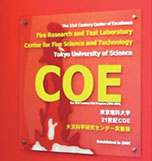
In March 2005, TUS opened the Fire Research and Test Laboratory, Center for Fire Science and Technology (hereinafter, CFSaT) as a research facility specializing in fire science that is equipped with world-class laboratories and equipment. CFSaT is located on the Noda campus. The CFSaT building area is approximately 1500 m2 with a total floor area of 1900 m2 and a ceiling height of 20 m. The members of CFSaT designed this research facility with its cutting-edge equipment based on their experiences, enabling world-leading research to be conducted here as a center of fire science.
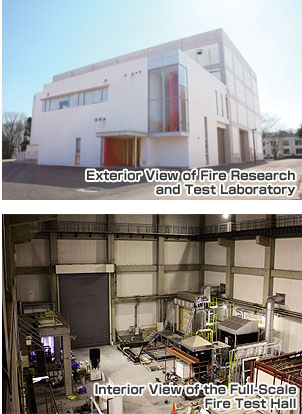
CFSaT is comprised of two major buildings, the Full-Scale Fire Test Hall and the Small Test Laboratories, according to their functionality. The Full-Scale Fire Test Hall is a large-scale laboratory with a floor area of 1000 m2 and a ceiling height of approximately 18 m. This building is adjustable to full-scale experiments that vary depending on such parameters as fire control or fire-proof performance of structural members and materials, burning behavior of combustible materials, and smoke movement. In order to provide practical education and research at the Center, as shown below, this building is equipped with devices and gauges that are capable of creating actual situations based on theory.
The Full-Scale Fire Test Hall is also equipped with essential tools for fire research such as smoke-collecting hoods and fire-proof furnaces. Utilizing the large-scale space, the building can be used for structural fireproof tests loaded with actual-scale structural members and frames, fire behavior tests of office spaces loaded with combustible furniture fittings and equipment, smoke behavior tests of an atrium space, and burning behavior tests of vehicles. The Small Test Laboratories are comprised of a multi-purpose experiment room, a cone calorimeter room, temperature and humidity controlled rooms, a library, an observation room, a data processing room, conference room, a precision measuring equipment room and a storage room.
Cone Calorimeter Testing Device (ISO 5660)
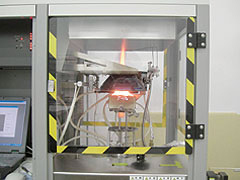
This device is used to examine ignitability and the exothermal properties of construction materials using thermal radiation. A test object is placed under the conical-shape electric heater which controls the thermal radiation to the object, and a pilot flame is applied to the object 10mm from its surface. The ignition time and the heat release rate can be measured per thermal radiation that can be set in the range of 0 to 50 kW/m2.
PIV Cobustion Field Measurement System
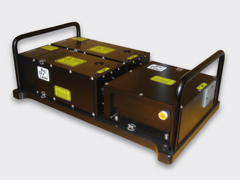
This system measures the instantaneous velocity and/or microscopic flow rate of, for example, the combustion field and the smoke plume motion. With this system, in the case of using a tracer (microscopic particles) and light source such as strobe light and laser, a picture of the reflection can be taken by an ultrafast camera to instantaneously obtain two-dimensional data of the flow rate on the target field.
Secondary Combustion Furnace
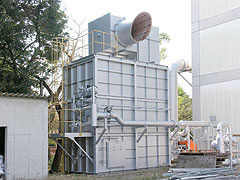
The smoke ventilation (collection) fan at the hood vacuums up the combustible gas containing black smoke that is induced from a burning source, and this furnace re-heats the smoke to 800 to burn completely and then eliminates the smoke. There are 4 heating burners which can produce 4.8 Mkcal/h in total.
Structural Fire Testing Furnace (Medium scale)
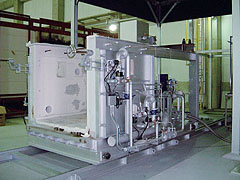
This unit is used to evaluate the fireproof performance of various structural members such as columns, beams, floors and walls. The unit can control the heat to the standard heating temperature and furnace pressure set by ISO 834. The heating furnace, with dimensions of 1.5 m (W) x 1.5 m (D) x 1.5 m (H), can also provide immediate heating.
Structural Fire Testing Furnace (Large scale, for Walls)
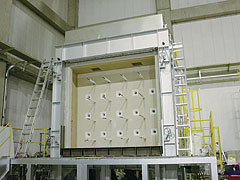
This unit is used to evaluate the fireproof performance of an exterior wall under fire and can control the heat to the standard heating temperature and furnace pressure set by ISO 834. There are 20 burners on the lateral side, and this can heat up to a 3.5 m x 3.5 m area. The unit is also suitable for performing heat tests.
Calorimetry Hoods (5 m × 5 m)
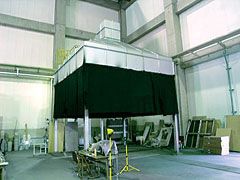
This unit is used to analyze the burning characteristics of furniture and equipment in a room by burning them and collecting the burning gas. The duct is equipped with devices for flow measurement and sampling. The design heat release rate is 2 MW at maximum, and the smoke suction power is 600 m3/min at maximum. A movable unit (4 m x 4 m) is also available.
Full-Scale Compartment for Fire Experiment (with Water Pump)
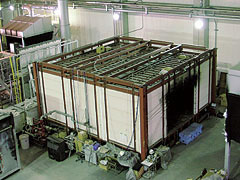
This fire compartment is 6 m (W) x 6 m (D) x 2.7 m (H) in actual size, and the sprinkler system can be attached to the ceiling. The compartment is mainly used to evaluate the fire extinguishing performance of sprinkler systems and also has used for experiments on smoke movement during sprinkler system activation.
Room Corner Testing Unit (ISO 9705)
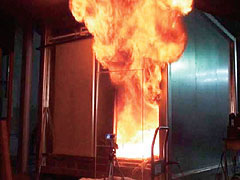
This unit is comprised of a space of 2.4 m (W) x 3.6 m (D) x 2.4 m (H) (approximately, the size of a 6-tatami-mat room) and an opening 0.8 m (W) x 2 m (H). It can be used to recreate a fire in a room with furniture and dry walls, which can be developed into a fully developed fire. In addition, flashover experiments can be performed with this unit by recreating fires that spread to entire rooms in a short time period, and then combustible gas concentration and temperature distribution data can be collected. The development of the fire can be captured by video camera.
ICAL Testing Unit (Heat Radiation Panel)

This unit is designed to elucidate the burning behavior of combustible materials under the condition where a certain heat flux was given through radiative heat transfer. The unit can also be used to investigate the behavior of members exposed to radiative heat. The panel heater has a heating area of 1.75 m (W) x 1.38 m (H). Members can be exposed experimentally to surface temperatures up to 950 and a heat flux of 50 kW/m2.
Smoke generation test unit & FTIR Gas Analyzer (ISO 10702)
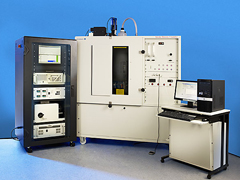
Smoke generation test unit
The smoke generation test unit is based on a device called NBS Smoke Density Chamber (SDC), and meets the requirements given in the ASTM E662-09 standard (Standard Test Method for Specific Optical Density of Smoke Generated by Solid Materials). NBS was the institution that preceded the current NIST (National Institute of Standards and Technology, the standards research body of the United States).
The FITR analyzer has performance in excess of the resolution recommended by ISO (0.5 to 4 cm -1 ) and can continuously perform qualitative and quantitative measurements (high-speed scanning at 10spectra/s) of the many intermixed components in the gas while keeping the combustion gas at a high temperature (180°C or higher) in order to prevent changes due to cooling.
Device specifications
• Sensor: ZnSe Peltier cooled MCT
• Measurement frequency range: 500 to 4500 cm -1
• Resolution: 3.86 cm -1
• Continuous scanning: 10 spectra/s
• Probe: Incorporates a 180 °C heater mechanism and a filter suitable for heating
• Sample line: 3 m, heating temperature 180 to 200 °C
• Types of analysis gases that can be measured: Able to measure 20 constituents CO, CO2, NO, NO2 , N2O, SO2 , HCl, HF, NH3 , C2H6 , C3H8 , C6H14 , HCHO, C 6H5 OH, CH2 CHCHO, H2O,HCN, and HBr in ranges from low concentrations (ppm) to high concentrations (%).
Structural Fire Testing Furnace(Large scale, for Beams, Slabs and Columns)

The unit consists of a compound furnace component and a load application component, and the external dimensions are approximately 7 m wide and 10 m long, with a height of approximately 6 m from the floor to the top surface of the furnace, and pproximately 10 m to the top of the load application frame.The furnace is a rectangular box constructed using a thermally insulating heat-resistant ceramic fiber block (1400 °C specifications) with a thickness of 300 mm as the top surface inside the furnace, and the dimensions of the upper heater are 3 m wide, 4 m long, and 3.5 m deep. Sixteen excess-air gas burners are fitted to each of the left and right furnace walls (for a total of 32 burners), and have a maximum rated combustion heating rate of approximately 29,000,000 kJ/h.
The load application unit has a reaction force frame and a movable load application frame (movement speed of 0.2 m/min) attached in a loop to the outer circumference of the furnace, as well as an oil jack with a stroke of 600 mm for applying loading and a load cell, both built into the load application frame. These can apply a maximum load of 5 MN to the test specimen.
Thermogravimetric differential thermal analyzer and gas chromatograph/mass spectrometer
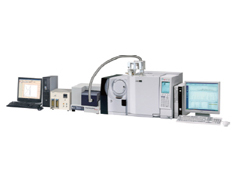
Thermogravimetric differential thermal analyzer and gas chromatograph mass spectrometer system (simultaneous measurement unit)
• Measurement temperature range: Room temperature to 1100 °C
• Maximum heating rate: 100 °C/min
This device combines a thermogravimetric differential thermal analyzer (TG-DTA) with a gas chromatograph/mass spectrometer (GC-MS) to offer more accurate analysis than either apparatus alone.
TG-DTA features the ability to analyze samples in extremely small quantities (in the milligram range). The unit heats and thermally decomposes samples using a constant temperature program, detects miniscule changes in mass and thermal energy due to processes such as oxidation, dehydration, and thermal decomposition of the sample. It also analyzes the thermal characteristics of materials from data on the reaction rate and thermophysical properties.
GC-MS performs mass analysis (mass spectral measurements) by decomposing the minute quantities of gas vaporized by TG-DTA and subjecting them to ion exchange. Whereas optical methods, such as ones based on infrared light, are commonly used for conventional gas spectrometry, this unit performs qualitative and quantitative analysis by measuring the molecular masses of the materials. This makes it possible to identify the material and clarify its properties. This is used for analyzing whether a developed material contains chemical substances that could have an impact on the human body, as well as for analyzing the thermal characteristics and other properties of materials, and is also expected to be useful for developing new fire-resistant materials.
 Japanese
Japanese

